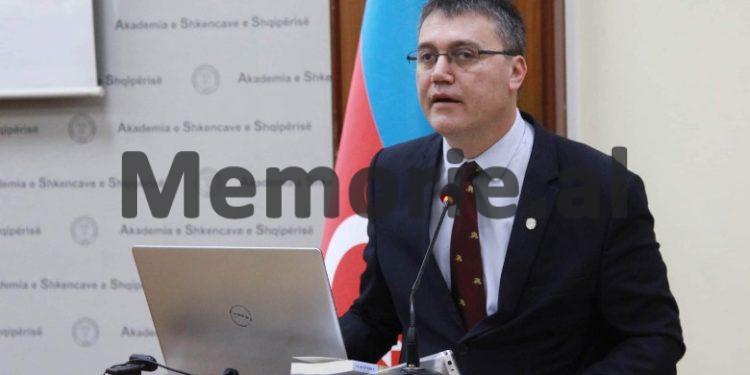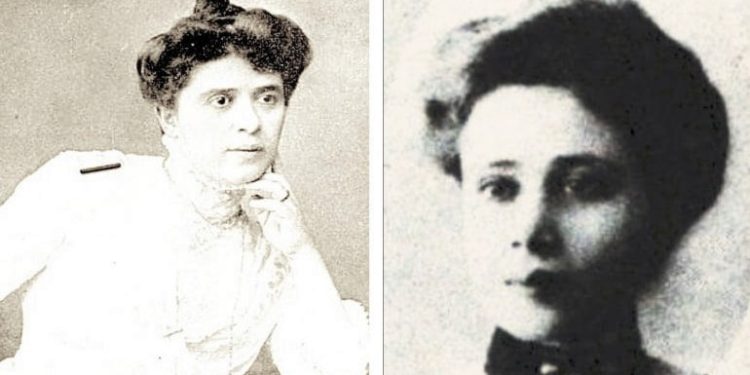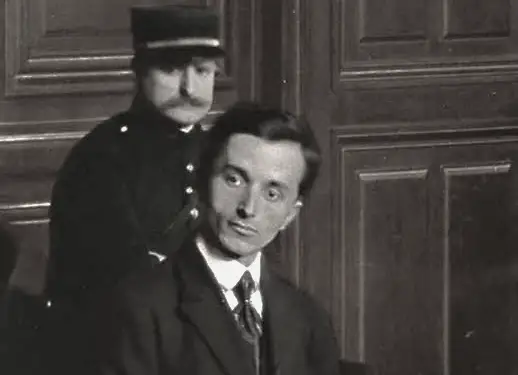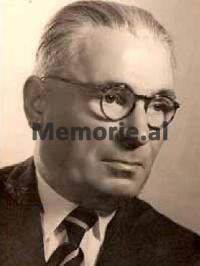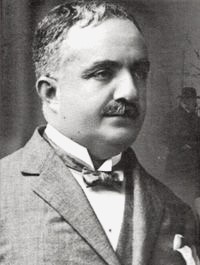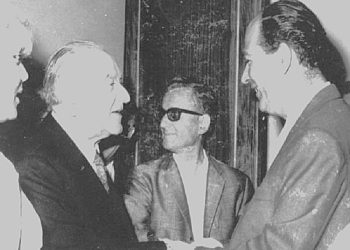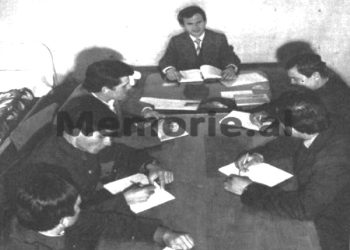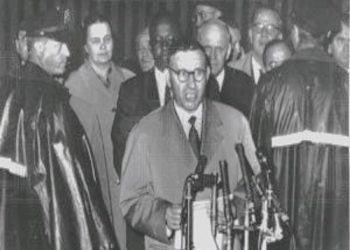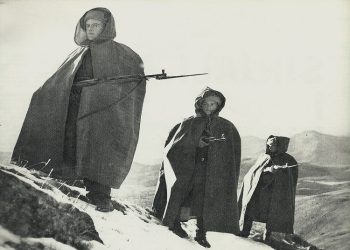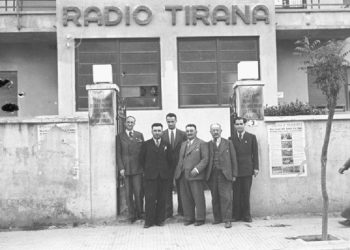By Dr. Dorian Koçi
Part One
Memorie.al / Modern Albanian journalism has its roots in the cultural humus of the city of Gjirokastra. Within a span of 10 years from 1920 to 1930, newspapers such as: Veli Hashorva’s “Drita” (published in Gjirokastra on March 27, 1920-1924), Xhevat Kallajxhiu’s “Demokratia” (published in Gjirokastra on November 28, 1925 and continued until 1939), “Labëria” and “Ideja kombëtare” (which were published in the periods when censorship stopped the publication of the newspaper “Demokratia”), “Fletore Popullore e Politike Kombëtare” (published in Gjirokastra for the first time on March 27, 1920-1924), “Fletore popullore” by Petro M. Harito (published in Gjirokastra with two and four pages, on November 3, 1923), “Neoshqiptarizma” and “Përpejka Shqiptare” by Branko Merxhani were published.
This important cultural development was a continuation of the efforts of the patriotic elite of the city of Gjirokastra and its participation in the Albanian state-building that began during the years of the National Renaissance and onwards. An important stage of the cultural awakening in Gjirokastra was undoubtedly the establishment of the “Drita” Club in 1908 and the “Liria” school, the same year in the Albanian language. These steps taken by the Gjirokastra patriots made it possible to spread the ideas of nationalism or Albanianism, as they created a reading public of the native language, which replaced the axiomatic inclusion of written languages in the minds of the people and destroyed religious solidarities, paving the way for the solidarity of the Albanian language and culture.
The Greek occupation of Gjirokastra in 1913-1916 attempted to interrupt the ongoing process of Albanian state-building, as Greece claimed to include Gjirokastra within the borders of the Greek state, within the framework of its open claims to the so-called “Vorio Epirus”. These annexationist attempts by Greece were opposed by the Albanian patriotic elite and the population of Gjirokastra. Moreover, in 1916, this risk was minimized, as Gjirokastra was included in the Italian occupation zone, after the forced withdrawal of the Greek army.
In the Italian occupation zone, Greek-language schools were closed and Albanian-language primary schools were opened, in which Italian teachers dominated and the teaching of Italian began to take first place. Short courses were opened for Albanian teachers, both in Gjirokastra and Vlora, where 135 people participated, and teaching materials and textbooks were brought from Italy. Meanwhile, the Italian government in the Vlora and Gjirokastra districts created a military administration, which was led by Italian specialists.
The number of schools in this area increased. Each school had Albanian teachers and Italian military teachers. Learning the Italian language was mandatory. For the training of Albanian teachers, short courses were organized in Vlora, while in 1917, 25 people were sent to attend a 3-month pedagogical course. The schools worked according to the program of Italian schools. In the 1917-1918 school year, a city school with a commercial profile was also opened in Gjirokastra, in which all lessons were held in Italian.
In 1921, when the French senator Justin Godart visited Gjirokastra during his tour of Albania, there were 11,000 inhabitants and 5 schools with most of the classes being mixed. These important cultural developments undertaken by the Italians in Southern Albania were overshadowed by the publication of the Secret Treaty of London (April 26, 1915), which envisaged a division of London Albania, as well as the Italians’ desire to annex Vlora and its surroundings, as an important geostrategic point in the Adriatic. In these political and cultural conditions created in Gjirokastër, as well as after the return to their homeland of several intellectual families from Gjirokastër from Turkey, such as the Kokalarës, the Kokonatës, the Alizotajs, etc., journalism in the Albanian language also emerged, as a successor to the best tradition of the press of the National Renaissance.
The first newspaper to be opened in Gjirokastër in the Albanian language was Gazeta “Drita” (1920-1924) with the patriotic editor and democratic publicist Veli Hashorva (1892-1975). Veli Hashorva was no stranger to the Albanian patriotic and national movement. He was a representative of an old Gjirokastra family, whose ancestors had administered the finances of the Vilayet of Ioannina. He had begun his patriotic activity in his hometown, Gjirokastra, as a member of the “Drita” club, founded there in 1908. In 1911, he went to Istanbul for higher studies in Political Science and returned to Albania in 1912.
Veli Hashorva, along with other Albanian students, including his friend Ali Këlcyra, interrupted his higher studies as a result of the outbreak of the Balkan Wars. As an activist of the National Movement, he was followed and persecuted by Greek forces when they occupied Gjirokastra in 1913. To escape further persecution, in May 1915, he immigrated to the USA, where he worked for the “Vatra” Federation. In 1916, he published the newspaper “Vjosa” in New York, with a national political spirit. On June 3, 1917, he was elected a delegate to the “Vatra” Assembly, which organized a campaign to collect an amount of 40,000 dollars ($750,289 at today’s exchange rate), to enable the Colony of America to send two representatives to the Peace Conference in Paris, Mr. Mehmet Konica and Mr. Turtulli.
Veli Hashorva returned to Albania in 1919, when Gjirokastra was still under the Italian occupation zone, along with Tepelena and Gjirokastra. According to a letter from Luigj Gurakuqi, sent to Parashqevi Qiriazi on December 6, 1919, from Paris, Veli Hashorva was an Advisor to the “Homeland”, who was returning to Albania together with Kol Tromara and Ilija Panon. After spending two weeks in Rome and meeting with Luigj Gurakuqi, Mehmet Konica and representatives of the Istanbul Colony, they returned to Albania.
Meanwhile, in Albania, in December 1918, just one month after the end of World War I, the Durrës Government was established, with Prime Minister Turhan Pashë Përmet. The government was formed by 14 members. This government would have the following names in its composition: 1. Turhan Pasha (chairman), 2. Preng Bib Doda (vice-chairman), and members: 3. Sami bey Vrioni, 4. Dr. Mihal Turtulli, 5.
Myfit bey Libohova, 6. Monsignor Luigj Bumçi, 7. Mid’hat bey Frashëri, 8. Luigj Gurakuqi, 9. Mehmet bey Konica, 10. Lef Nosi, 11. Mehdi Bey Frashëri, 12. Fejzi bey Alizoti, 13. Mustafa Kruja, 14. Pjetër Poga.
The Durrës government was under Italian influence. Pro its policy was Myfid Libohova, Fejzi Alizoti, Mehdi Frashëri, Sami Vrioni, Mustafa Kruja. A secret treaty between the provisional government of Durrës and the government of Italy was signed by ministers Myfid bey Libohova, Fejzi bey Alizoti and the advisor of the Italian Legation in Albania, Marquis Karl Durrazzo. According to him, a high commissioner of Italy controlled and decided on the affairs of the Albanian government, as well as on important decisions such as the budget, construction, concessions, appointments, and vacations in the administration. Italy considered this government as a delegation to the Italian government, which, without the permission of Adetto Gobi, did not make any expenses.
Under the conditions of an Italian protectorate, the Government of Durrës found it difficult to take steps related to the issue of Vlora, its hinterland. Gjirokastra, after pressure from Albanian patriotic circles, surrendered to the Government of Durrës on December 21, 1919 and the Italian troops withdrew but continued to occupy the hinterland of Vlora, including the city of Tepelena. In January 1920, Veli Hashorva participated in the Congress of Lushnja, as one of the representatives of Gjirokastra. The people of Gjirokastra enthusiastically accompanied their representatives to the Congress of Lushnja. On January 8, 1920, when delegates Veli Hashorva and Kiço Koçi left Gjirokastra for the congress, at a rally, the people shouted: “In Lushnja, in Lushnja”, “We are with Lushnja”!
The holding of the Lushnja Congress was opposed by the Durrës governors and the Italian occupiers, but it finally managed to hold, making very important decisions for the future of Albania. Its decisions aroused great resonance in Albanian patriotic circles and were greeted everywhere. There, a political union of an alliance of all strata and political groups was achieved, which quickly bore its fruits.
Veli Hashorva’s experience as a journalist in the USA, as editor of the newspaper “Vjosa” and contributor to the newspaper “Dielli”, as well as the goals of re-establishing the Albanian national state, which were revealed at the Lushnja Congress, encouraged him to establish the newspaper “Drita” in Gjirokastër. Its first issue was published on March 27, 1920, two months after the Lushnja Congress and on the day of the constitution of the High Council with 37 members, which is considered the first Albanian parliament.
According to the memoirs of Veli Hashorva, the name “Drita” for the newspaper was proposed to him by Petro Poga, former Minister of Justice in the Vlora government and one of the directors of the “Drita” newspaper in the Albanian language in Istanbul, in 1884. The first issue of the newspaper was published secretly, to surprise the people. The small ceremony of opening the newspaper took place in the courtyard of the “Drita” primary school, where a group of citizens were invited, among them some women, the mayor, the prefect and the deputy prefect of the city, etc.
Here the responsible director of the newspaper, Veli Hashorva, gave a modest speech, in which he said: “Gentlemen, I am immensely happy to have the honor of speaking in my city where I was born and raised, for the first time in front of a majority of patriots, who are also the most distinguished people of Gjirokastra. But what makes me happier is the joyful occasion that caused this meeting, which will remain precious in the history of our city and in my personal life”.
One of the first results of the Lushnja Congress was the organization and support of the War of Vlora that guaranteed the territorial integrity of Albania, internationally recognized in 1913. For this reason, the “National Defense” Committee was created in 1919, as a reaction to the government of Durrës that, with its fatalistic attitude towards the dangers of fragmentation, was preventing the start of an armed movement to solve the problem of the Albanian territories, which were still under Italian and French occupation. Representatives of this current of thought in Albanian patriotic circles were Turhan Pasha Përmeti, the prime minister of the Durrës government, Mustafa Kruja, minister of Myfit Bey Libohova, a minister without portfolio, who had a great influence in Libohova and Gjirokastër.
Ali Këlcyra writes in his memoirs that in December 1919, Myfid Libohova, who returned from Paris and Rome (…) gave a speech in Vlora and especially in Gjirokastër, before the country’s leadership and showed that it was almost impossible to save the independence and especially the territorial integrity of Albania. As Gogol, of course, he pointed to the Greek invasion that terrified the entire patriotic people. With such speeches, Myfid and his friends (…) wanted to convince the people that the only hope of salvation was to seek the Italian Protectorate. Albanian nationalism, and especially the “National Defense”, was strictly against this propaganda.
The opposition to these fatalistic thoughts and the preparation and support for organizing the War of Vlora, would find ample space in the pages of the Newspaper “Drita”. In one of the articles of the newspaper “Drita”, it was written that: …. “Vlora is ours, it belongs to Albania, and we will never accept any choice or agreement that can be made for it….! The great powers can give Vlora to Italy, with as much hinterland as they want. But the Albanians will not be convinced; it is dear and sacred to us….”!
Veli Hashorva participates in the War of Vlora, as a volunteer and war correspondent. He reports in the pages of the newspaper, directly from the war front: “All places except Llogara, fell under the brilliant attacks of the Albanians”. He is one of the members of the Gjirokastra commission that declared the victory of the War of Vlora and organized the ceremony of the occasion. The proclamation states that citizens, the holy Vlora, which holds the balance of life and homeland, was liberated by the precious blood and heroism of the race, which today glorifies the flag of high triumph.
At the same time, the newspaper “Drita” would come out in defense of Avni Rustemi, when the latter was being tried in Paris, for the murder of Esat Pasha Toptani. Gjirokastra protested in defense of Avni Rustemi. On November 29, 1920, a large rally was held in the city, after which a motion was sent to the Paris court: “We beg the high jury of the French nation, noble and liberal, to acquit Avni Rustemi, the executioner of the guilty of high treason Esat Toptani, and to take into consideration that Avni acted thus to save the Fatherland.”
Protests were from all over the country, even from countries and friends from all over the world, under whose pressure Avniu was released. Not even a month later, on December 25, 1920, at 7 am, he emerged into the harbor of Vlora. He was welcomed by a large crowd. In the Municipality of Vlora, Avniu gave a speech and received congratulations from the people. The newspaper “Drita” of Gjirokastra welcomed him to the Homeland, writing: “Accept the congratulations of the people, the blessings of the dead, the wishes of parents and the blessings of friends. Welcome, Avni Rustemi!”
The 1920s are also the beginnings of Albanian parliamentary democracy. The political groups and parties that will line up in parliament will often have localist, provincial colors, but will sometimes be influenced by the associations and groups that have voted for them. Veli Hashorva is one of the organizers of the “Drita” Society (1921-1924). The “Drita” Society was a democratic, educational, cultural and political club that operated in Gjirokastër. It was also called the “Opingarëve” club, since its symbol was a pair of opinga, which personified ordinary people. Its organ was the newspaper “Drita”, which was directed by Veli Hashorva.
The “Drita” Society achieved good results during the election campaigns for the highest bodies of power in 1921 and 1923. It strengthened its democratic and liberal activity especially during the June 1924 Movement, which Fan Noli and Ali Këlcyra have named the “June 1924 Revolution”. The “Drita” Society, since the 1921 elections, lined up against Myfi Libohova and his supporters in the Prefecture of Gjirokastra. The “Drita” Society seems to have been inspired by socialist ideas that had begun and taken root in the Albanian environment. It is very likely that, like other students in Istanbul, Veli Hashorva read socialist ideas in the newspaper “Turk Huku” (“Turkish Justice”) that propagated socialist ideas.
The “Drita” Society participated in the Congress of Societies held in Vlora, where the “Atdheu” Confederation was formed. In an announcement in the “Agimi” Magazine published in Shkodra, it is written that; on June 3, 1921, the “Drita” Society of Gjirokastra declared its unification with the “Atdheu” Federation, with Mr. Avni Rustemi present who was elected chairman of the general meeting. The members of the “Atdheu” center of Gjinokastra were elected as follows: Chairman Mr. Petro Poga, Secretary Mr. Veli Hashorva with three other members, who are Mr. Kiço Koçi, Mr. Hasan Xhiku and Mr. Beso Gega.
Veli Hashorva, under the influence of social conditions, had made for himself the motto of a rapid progress, so necessary in the Albania of that time still not urbanized. This progress was usually perceived as a contradiction between the old Albanian elite, formed during the Ottoman Empire with a pronounced nostalgia for the privileges inherited from the “ancien regime” and the youth, who sought a rapid modernization based on merit and cultural progress. All these groups, such as the “Drita” Society in Gjirokastër, “Neither the Pasha nor the Bey” in Elbasan, would be very sensitive to political power and especially the land issue, which constituted a key point in the relations of civic equality.
Most of the landlords and the old political elite did not want an agrarian reform, as they claimed that the land was hereditary, while the young intellectuals who came from the middle classes claimed that the land the landlords had acquired as a result of the privileges they had in the Ottoman Empire, so it should be subject to agrarian reform.
While most of the peasants owned less than 1.8 ha. of land and many others had none at all, seven large families, the so-called landlords, with properties over 2000 ha., controlled vast plain areas of Western and Central Albania. At this time, important representatives of the large landowners, such as Ali Këlcyra, deputy for Gjirokastra in the Albanian Parliament, thought that the landlords should give the peasants a piece of land as property, to enable the opening of the path towards Agrarian Reform. Memorie.al




